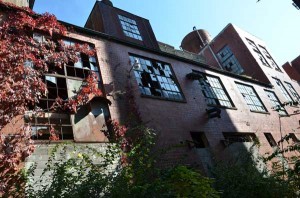By Richard Thomas
When Lyons Spirits built a distillery and started making Town Branch Bourbon and Pearse Lyons Reserve, they reintroduced bourbon-making to Lexington, Kentucky after an absence of more than five decades. Until that time, the most visible sign that Lexington was a whiskey-making town had been the old James E. Pepper plant on Manchester Street, Lexington’s last working distillery.
Yet the industrial ruins of the Pepper distillery were hardly the only remnants of Lexington’s whiskey history. Other buildings from that bygone era still stand, although these are so innocuous compared to the Pepper distillery as to barely attract notice.
Manchester Street’s Other Survivors
Now even more prominent among the surviving remnants of Lexington’s bourbon industry than the Pepper distillery is Buster’s Billiards, which first opened its doors in downtown Lexington during my college days, and quickly became a nightlife fixture. The location of the original Buster’s was demolished in a typical Lexington real estate boondoggle, forcing the popular bar to relocate to a much larger venue west of downtown, just up the road from the James E. Pepper ruins.
Although they now call that area “The Distillery District,” few patrons of Buster’s are aware that they are bellying up to the bar in what used to be a warehouse of the Ashland/Old Tarr Distillery. The distillery was closed at in the early 1900s, and its abandoned bottling plant was destroyed in a fire in 1986.
Another Ashland/Old Tarr warehouse served as the storage and distribution center for King’s Foods until the company closed up shop. That building is vacant, but it still stands and is at the center of plans for redevelopment into a retail space. Nothing whatsoever remains of the Lexington Distillery, another Manchester Street whiskey-maker, whose facilities were demolished in the 1880s.
Lexington: Dotted With Remnants
Just as Lexington once had a thriving whiskey industry, so to the Fayette County of today is dotted with the hidden remains of that industry. Like the Ashland/Old Tarr Distillery, the Commonwealth Distillery closed its doors in the early 1900s. Today only one building remains, the brick warehouse at the center of Hillenmeyer Nursery.
The Grimes Distillery closed its doors in the late 1890s, but the mill building continues to survive to this day as the clubhouse of the Iroquois Hunt Club, a group pursuing English foxhunting. Unfortunately, the Iroquois Hunt is a private club, so the old distillery mill is one of the harder remnants of Lexington’s whiskey history to visit.
Of the eleven other known and now defunct Bluegrass distilleries, nothing so obvious as even a ruined building remains. These old whiskey sites might have left behind the odd brick or two, and perhaps even some shards from broken glass bottles, but those are the purview of the archaeologist rather than the curious whiskey-lover.
 The Whiskey Reviewer A World of Whiskey, Poured Every Weekday
The Whiskey Reviewer A World of Whiskey, Poured Every Weekday

